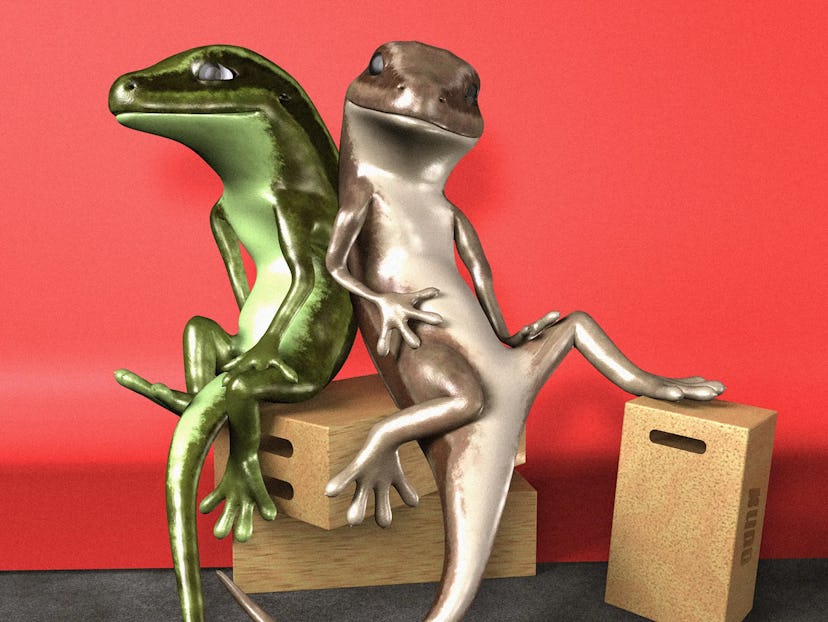How Two Talking Lizards Went From Instagram Sensations to a Major Museum

About a month into lockdown in April 2020, I came across an Instagram video featuring two animated talking lizards. The corresponding audio was the exact version of a conversation I’d had with friends and coworkers in the past few weeks. “I mean, to be honest, I’m kind of into this confinement thing,” one of the amphibians says as the pair surveys Bed-Stuy, Brooklyn from an apartment rooftop. “I’ve been fantasizing about not having any plans and just having to stay home and do things I never have time to do. And also work and make music and listen to music and just like… not have any obligation or plans that I wanna cancel. So in a fucked up way… I’m loving this.” (Were we ever so young?) “That’s such a quarantine week one thing to say,” her lizard friend responds.
These voices belonged to Meriem Bennani and Orian Barki, the two artists behind the eight-episode video series 2 Lizards spanning the first three and a half months of lockdown. No one likes revisiting those harrowing early days, but Covid-19 is just the framework for exploring something bigger: humans, relationships, and emotions. For proof of that fact, the Whitney Museum of American Art just mounted an exhibition featuring all eight videos. (Look for the trail of lizard footsteps to find it on the fourth floor.)
Back in April 2020, I reached out to learn more—and quickly got shot down. The two artists didn’t want to come across as making the pandemic about themselves, nor turn the project into a commodity. They ended up accepting a New York Times interview request later that month—not because of the publication’s reputation, but to help Bennani and Barki (who are from Morocco and Israel, respectively) maintain their American visas.
Nowadays, the 2 Lizards series is a time capsule—and a rather uplifting one, when you consider how far we’ve come. (New York City residents: remember that summer when fireworks were a constant, or seven p.m. signaled that it was time to go to your window and clang pots and pans? Remember the concept of strolling through Times Square and not encountering a living soul?).
My first question when I finally do reach Bennani and Barki for an interview is: Why lizards? It was something of an accident, they tell me. Bennani had just bought some 3-D animal models for another animation project. She and Barki were discussing collaborating when the idea came to use the aforementioned conversation as material. They continued to lift lines directly from their talks in the episodes that followed, which is a key part of how the whole series feels so real. “It was just very spontaneous,” Barki recalls. “It wasn’t symbolic. If we tried to make something similar now, we already have too much perspective. And I think that’s what gives this series archival and historical value.” To her, the jump from Instagram to an institutional setting like the Whitney makes perfect sense.
The series ended up being key to maintaining a semblance of a social life for Bennani and Barki. The pair invited their friends to choose animals to represent them and send voice memos of improvised lines whenever inspiration struck. “It was a way of hanging out remotely,” Bennani says. Apart from the seventh episode, which stars a rodent news anchor reporting on the Black Lives Matter protests in July of 2020, everything was taken from the personal experiences of those around them. Expanding the cast of animals allowed Bennani and Barki to explore a whole host of feelings, whether they went through them or not. Throughout the series, we see the animated creatures experience having to move back home after a job loss, reveling in the thrill of a sexual encounter after going so long with physical touch, and feeling like they’ve dreamt showing up to work without pants on the first time they forgot their mask. (Not to mention working without pants becoming a part of their daily routines.)
There are a handful of characters whom Bennani and Barki don’t know personally—namely Anthony Fauci, who makes a cameo as a frog, and a police chief who is, quite fittingly, a pig. And there is one in particular whom they didn’t know prior to deciding that they should speak with an essential worker on the front lines. A friend put them in touch with a nurse, and they went to her house to conduct a (socially distanced) interview which they then edited in the style of a documentary—a medium I’m not surprised to learn is part of Barki’s background. It’s also the genre that I’ve come to consider the films—something I never would have expected when those two lizards first popped up on my screen. I would have called them something akin to an art world Instagram sensation—another “quarantine week one thing” to say.
This article was originally published on